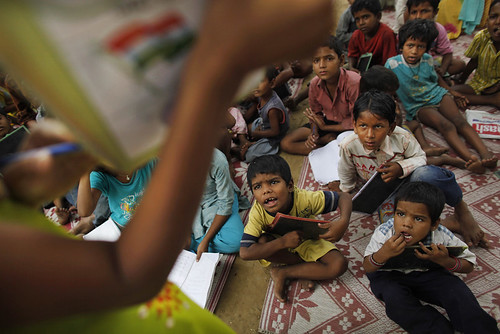An elementary school classroom in a slum was published by Stephen Spender in 1964. The poem resonates the poet’s political views and brings forth the difficulties faced by the kids in slums. This poem was written to highlight the social injustice prevailing at that time in the world. The following article summarizes his views and is divided stanza-wise for ease in understanding.
Stanza 1
The poet says that the condition of the children in a slum school is pathetic. Their world is far removed from the open, healthy environment. They are as unwanted as the rootless weeds. Their hair is unkempt and they have pale faces which clearly indicate their deprived and under-nourished condition. These children, as the tall girl, are stressed by the burden of their circumstances. They are exhausted both physically as well as emotionally. The paper thin boy is skinny. His eyes have a scared look. These unfortunate beings have inherited only disease and bad luck from their parents. One of diseased ones can’t even get up from the desk to recite his lesson. However, there is one child at the back of the class who is younger than the others. His inexperienced eyes are full of hope and he is dreaming about playing games in the open. Apparently gloom has still not enveloped him.
Stanza 2
The classroom walls have a dirty appearance as they haven’t been painted for a long time. In other words, these children inhabit a world which is dreary and depressing. On the walls are displayed the names of people who have given donations. The bust of Shakespeare with the background of a clear sky at the time of sun-rise is also displayed. The walls also have scenic pictures of Tyrolese Valley with its beautiful flowers presenting a world of the heavenly splendor. Apart from all this, the walls also have a map revealing the world which they view from the classroom’s windows which is foggy and harsh. It represents a dark and bleak future with no hope for amelioration. Their eyes can only view a narrow road which is enclosed with a dull sky. The poet suggests that these children are trapped in a hopeless situation and their reality is far removed from the literary world which glistens with the beauty of nature such as the rivers and the high land jutting from the sea.

Stanza 3
The pensive poet suddenly turns belligerent(aggressive) and feels that Shakespeare is ‘wicked’. This is because he misleads the children. He shows them a beautiful world of ships, sun and love which is not only unreal for them but it has a corrupting influence on these children and instigates them to steal and try to escape from their cramped holes. Their existence is indeed, very sad. These emaciated children are so thin that it appears that they are ‘wearing’ skins. The spectacles they are wearing have glass which has been broken and mended. Their entire appearance reeks of their deprivation. The poet shows his outrage by suggesting that the maps on their walls should show huge slums instead of beautiful scenic graphics.
Stanza 4
In a conciliatory tone the poet appeals to the governor, inspector and visitor to do something to improve their condition. If there is political will this map showing the beautiful world outside can become their reality too. The poet hopes the authorities would realize their moral responsibilities and free these children from their grave-like entrapments. He wants all the barriers to be pulled down; barriers that keep away true education from them. The children must be given freedom to experience the wholesome bounties of nature-view the green fields and run on ‘gold sand’. Let them read books and let them breathe in fresh air. Let them discover themselves and let them be creative so that their names can also enter the books of history. Let them find their place in the sun.

